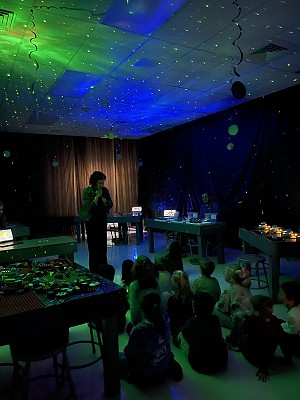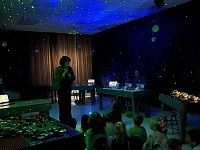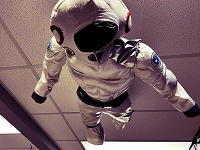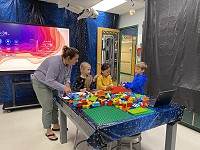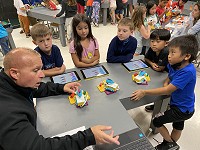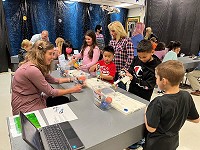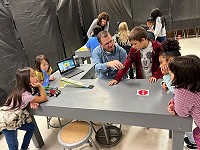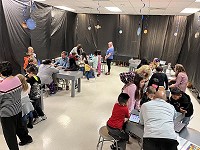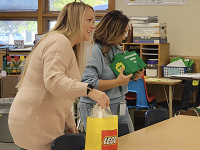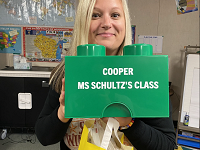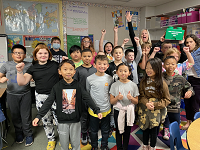LEGO Immersive Space Pilot Program a Huge Success
November 4, 2022
Sheboygan Area School District’s Instructional Technology team was “Ready to Launch” with their LEGO Immersive Space Pilot Program in October, and it was a huge success! A project led by Michael Jaber, Instructional Technology Coordinator, Ready to Launch is a first-of-its-kind, space-themed learning experience for kindergarten through fifth-grade students. It consists of five learning stations that engage students in 4C activities - critical thinking, creativity, collaboration, and communication.
“Whoa, cool!” could be heard from many Cooper students as they entered the transformed classroom space. Blinds were drawn, the classroom lights were off, black drapes covered the walls, planets hung from above and the entire ceiling was transformed into a colorful sea of galaxies and stars. A stuffed astronaut hung from the ceiling, and students looked up in awe as they passed by.
Ready to Launch is based on an activity that the Instructional Technology team was introduced to at their International Society for Technology in Education (ISTE) training in the summer of 2022. ISTE is a non-profit organization that seeks to promote the integration of technology in teaching and learning. Attending this training gave the district’s team a fantastic opportunity to connect with the LEGO Education Team. From there, the team worked closely with three LEGO EDU Team members - Steven Weniger, Colleen Cannon-Ruffo, and Dr. Jenny Nash - to create Ready to Launch.
During this unique hands-on experience, students split up into teams to work through each of the five stations in different groups. Stations were geared toward their specific ages and comprehension levels. Each team of students was required to complete the task at each station within six minutes, and ten points were awarded upon completion. Each class grouping could earn up to 50 total points in their session. The class with the most points won bragging rights and a LEGO trophy filled to the brim with LEGO-themed suckers and bracelets!
The stations were as follows:
Station 1: LEGO Free Build
Students had to work as a team to construct a rocket out of a table of LEGO bricks and elements. If they built something that resembled a rocket and worked collaboratively, they received 10 points.
Station 2: Vehicles on the Moon
The student teams needed to test three different types of vehicles to see which would work best on the moon. The three vehicles were a sail car, a vehicle that used gravity to slide down a ramp, and a vehicle that used propulsion to move by using a spring-loaded pusher. The students had to consider all of the conditions/factors on the moon and decide which vehicle would work best for them to reach a designated target. If they chose the correct answer (propulsion) through inquiry-based learning, they received 10 points.
Station 3: LEGO Alarm
Students discussed how we keep astronauts safe by using alarms on spacecraft. At this station, students used block coding to create brand new alarm sounds uploaded to a pre-built LEGO alarm. Students coded their own sounds through the program and uploaded them to the LEGO alarm. If they were able to do this, they received 10 points.
Station 4: Space Grabbers
Students had to use "Space Grabbers" made from LEGO elements to pick up space objects and put them into the specimen bin. Some of the objects were too big or heavy to use the grabbers, so students had to realize they needed to use teamwork (utilize another grabber) to pick up the items. If they picked up at least five items and put them into the bin they received 10 points for that station.
Station 5A (Grades K-2): Coding the Space Train
This station featured a space train that needed to complete three actions through the use of colored blocks. Each block color had a different action associated with it. The actions to be completed by the Space Train consisted of stopping for a suitcase (red), gas, food, and space slushies (blue), and then using the green block to go back. The yellow and white blocks were lights and sounds so the kids could put those anywhere they wanted on the track. If they completed all the actions they received 10 points.
Station 5B (Grades 3-5): Coding the Moon Rover
This station challenged the students to navigate obstacles on the moon by using directional block coding to reach a designated target. Students had to choose the proper distance for their rover to travel as well as the direction it had to go by using the block coding interface. If they reached the target they received 10 points.
Ready to Launch has been experienced by several schools in the Sheboygan Area School District, and the Instructional Technology Team looks forward to sharing this program with more students in the future!
